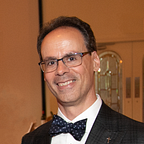CRISPR Patent Summary Report
In this next in a series of industry-specific Inventiveness Index reports, we look at CRISPR innovation in the USA. By using patent production as the proxy for measuring quantity (not necessarily quality) of innovation, this report answers three main questions (plus a few other insights):
- What are the top metro areas in the USA for innovation in CRISPR?
- Who are the top innovators?
- Where are the largest concentrations of CRISPR talent?
First: What is “CRISPR”?
Some readers may have heard by now of “gene-editing”. And more specifically, the form of gene-editing called “CRISPR-Cas9”.
CRISPR is a biomolecular acronym that stands for “Clustered Regularly Interspersed Short Palindromic Repeats” in bacterial DNA. In short, is refers to a genetic mechanism that some bacteria developed to protect themselves from certain kinds of viruses.
In 2012, two scientists discovered how to harness this mechanism to make changes to DNA, any DNA — including human. This technology holds promise for a wide range of things from making mushrooms brown slower, to eliminating malaria (by mosquito-genocide), or correcting certain vision problem in humans, or “editing” a human embryo to knock out the gene that causes sickle-cell anemia.
What are the top metro areas in the USA for innovation in CRISPR?
As Table 1 and Figure 1 show, the Boston and San Francisco metro areas hold a commanding lead over the remaining 32 metros in the production of CRISPR-related patents. These two metros hold a projected (by the end of 2021) 65.5% of all the CRISPR related patents in the USA. NYC and San Diego hold a distant 3rd & 4th position with 4.30% and 4.25% respectively. The bold red line shows the total national CRISPR patent output (2021 is projected). CRISPR will have garnered about 400 patents since 2014. Compare this to the recent blockchain report we issued that showed about 1000 patents issued in the blockchain space since only 2017.
It is common that when a very novel kind of thing appears, at first, because there is nothing to compare it to, time to issuance is fast. Then as patents accumulate, patent prosecution time slows down and eventually plateaus. As seen in the adjoining Figure 2, for comparison, we see this trend beginning (orange line in lower right) for blockchain patents. However, the upper blue line for CRISPR patents is a much longer, and more erratic pattern suggesting that these patents are more complicated and harder to compare to “prior art” (the term the US Patent Office uses to refer to past patents).
Who are the top innovators?
Figure 3 shows the top ten assignees based on patent counts. The top four, collectively, hold 208 patents (56.7%) of the 367 that have been issued to date. However, if we include all academia owned patents, that number rises to 39 institutions (44.8%) of 87 total and 281 patents or 76.6% of all CRISPR patents. (NOTE: in some cases, a single patent is assigned to more than one academic institution, or sometimes both an academic and a for-profit entity such as a few co-owned by The Broad Institute and Editas Medicine because Dr. Feng Zhang works at both.)
Figure 4’s two charts shows that more and more organizations are getting into the CRISPR innovation race, year by year. However, we see that academia (pale blue bars) still accounts for an outsized percentage of the organizations that are patenting with CRISPR, and the patents they are obtaining. This suggests that CRISPR is still primarily in the scientific and primary research phase.
Looking at an organization-by-organization patent production rate we see a few examples (Note: Year 2021 is real thru 26-Oct then projected for year-end) (Note: Blue=Academic, Green=Corp):
Where are the largest concentrations of CRISPR talent?
Figure 6 shows the highest concentration of CRISPR innovative talent is in the Boston metro and San Francisco metro regions. This is because the basic science of CRISPR was discovered and developed by Dr. Jennifer Doudna (and Dr. Emmanuelle Charpentier at Univ of Vienna in Europe) from UC Berkeley near San Francisco and a number of advances since then have come from Dr. Feng Zhang and Dr. George Church of the Broad Institute in Boston.
As Figure 7 illustrates, 46% of CRISPR inventors are academics, which further signals a nascent industry where for-profit entities have not yet become the dominant producer of patents.
Conclusions:
- CRISPR is still largely a primary science research exercise. Commercialization is coming. Universities and companies are both racing to turn the science into workable technology that can be commercialized.
- We are very early in the patent curve for this technology.
- There have been some rather large and significant patent disputes around CRISPR already. This plus the very complex nature of the science and technology — will make getting CRISPR patents long and difficult.
About Patent Index and the Inventiveness Index:
Patent Index provides patent law firms, economic development entities, publishers and corporations with patent-related data feeds, weekly email alerts and expert custom analysis. The Inventiveness Index is a “social-good” vehicle for analysis that Patent Index finds more broadly useful to the cause of advancing innovation in the USA; like the first ever Gender in Invention report (August of 2017) and others.
Interested in getting a weekly email alert for new CRISPR-related patents?
Interested in more details about this report?
Learn more at www.PatentIdx.com and www.InventivenessIndex.com or contact the author at Joe at PatentIdx dot com.
